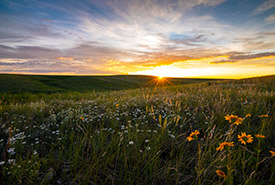Indigenous rights and private land conservation: Opening the door to collective responsibility

The sun setting on a prairie of wildflowers at Old Man on His Back Prairie and Heritage Conservation Area in southern Saskatchewan. The Nature Conservancy of Canada has been engaging with a group of Indigenous advisors from local nations to develop a Bison Management Plan for these lands, which are part of the traditional territories of the Niitsitapi, Nakoda, Dakota, Lakota, Anishnaabe, and Nêhiyawak Peoples as well as the homeland of the Métis. (Photo by Jason Bantle)
This blog is an accompaniment to a report by Conservation through Reconciliation Partnership entitled: Respect and Responsibility: Integrating Indigenous Rights and Private Land Conservation in Canada. A Guide for Land Trusts and Other Non-Governmental Organizations
This blog, written by Larry Innes and Ian Attridge, originally appeared on Conservation through Reconciliation Partnership’s website and is reposted with permission.
In Canada, land trusts, not-for-profit conservation organizations and government agencies have sought to conserve private lands for their ecological, agricultural, recreational or cultural value through acquiring ownership or other legal interests. Often termed securement, this process has a long and contentious history.
Despite creating significant public benefits, private land conservation has often occurred without a full appreciation and understanding of the impacts on Indigenous rights and title. Canada, as a nation, was built on lands that were already occupied by Indigenous Peoples, who were living on their own lands, under their own laws at the time of “discovery” and colonization by Europeans. As noted by the Truth and Reconciliation Commission:
“For over a century, the central goals of Canada’s Aboriginal policy were to eliminate Aboriginal governments; ignore Aboriginal rights; terminate the Treaties; and, through a process of assimilation, cause Aboriginal peoples to cease to exist as distinct legal, social, cultural, religious, and racial entities in Canada.”
Similarly, the dominant concepts of “private ownership,” “development” and “conservation” were developed in the European context. They are loaded with cultural assumptions and legal concepts that are different from how many Indigenous societies understand relationships between people, lands, waters, plants and animals.
Without a significant paradigm shift, private land conservation practices will continue to perpetuate unreconciled relationships among Indigenous Peoples, non-Indigenous peoples and public governments.
Our recent report, Respect and Responsibility: Integrating Indigenous Rights and Private Land Conservation in Canada, explores the historical, legal and policy landscape of private land conservation in what is now known as Canada, and sets out pathways for meaningful engagement with Indigenous governments and respect for Indigenous jurisdiction.
The report provides guidance for private land conservation organizations seeking to adapt their practices and build respectful and appropriate relationships with Indigenous Nations. But it is also relevant for legal practitioners in real estate or private property law, funders and private individuals who hold conservation lands.
This report was produced through the Conservation through Reconciliation Partnership by Larry Innes (OKT Law), Ian Attridge (Barrister and Solicitor and Trent University) and Skeena Lawson (JD Candidate University of Victoria) with support from the Nature Conservancy of Canada.
We asked co-authors Larry and Ian to share the story about how this report came about, what they’ve learned and the impact they hope it will have in private land conservation practice. Overall, they hope that this report opens doors to important conversations for how we can collectively transform private land conservation to recognize and respect Indigenous governance and self-determination.
Click on the play button on each sound clip below to hear their responses. A full transcript is available here.
Question: Can you tell us the story of how this report came about?
Q: What are the key takeaways from the report and why are they important?
Q: Apart from the key audiences (land trusts and other NGOs) who else would find this report helpful and why?
Q: In your analysis, what have you learned about the evolution of private land conservation practices in Canada? What more needs to be done?
Q: Can you provide a concrete example of a land securement process where Indigenous governments or Nations were meaningfully engaged and Indigenous jurisdiction was respected?
Q: What impact do you hope this report will have within the conservation sector in Canada?
Q: Do you have any additional thoughts you’d like to share?

